Seed Starting Guide
Starting plants from seed is easy. You can start vegetables, herbs, and flowers from seed.
Seed starting requires a bit of time and space. The effort will be rewarding. Many more varieties of vegetables and flowers–both annuals and perennials– are available in seed than are young seedlings or starts offered at garden centers or nurseries. Starting plants from seed is less expensive than purchasing plants.
Most vegetables can be started from seeds sown directly in the garden. Some–mostly semi-trouble plants such as tomatoes and peppers–are best started indoors. To get the most out of the growing season, seeds can be started indoors before the last frost then the young plants can go into the garden as soon as the weather has warmed in spring.
Seeds of cool-season vegetables can be sown directly in the garden as early as 2 to 8 weeks before the last frost. Seeds of warm-season vegetables are best sown directly in the garden a week or two after the last spring frost. Start seeds indoors 8 to 10 weeks before they will be transplanted into the garden.
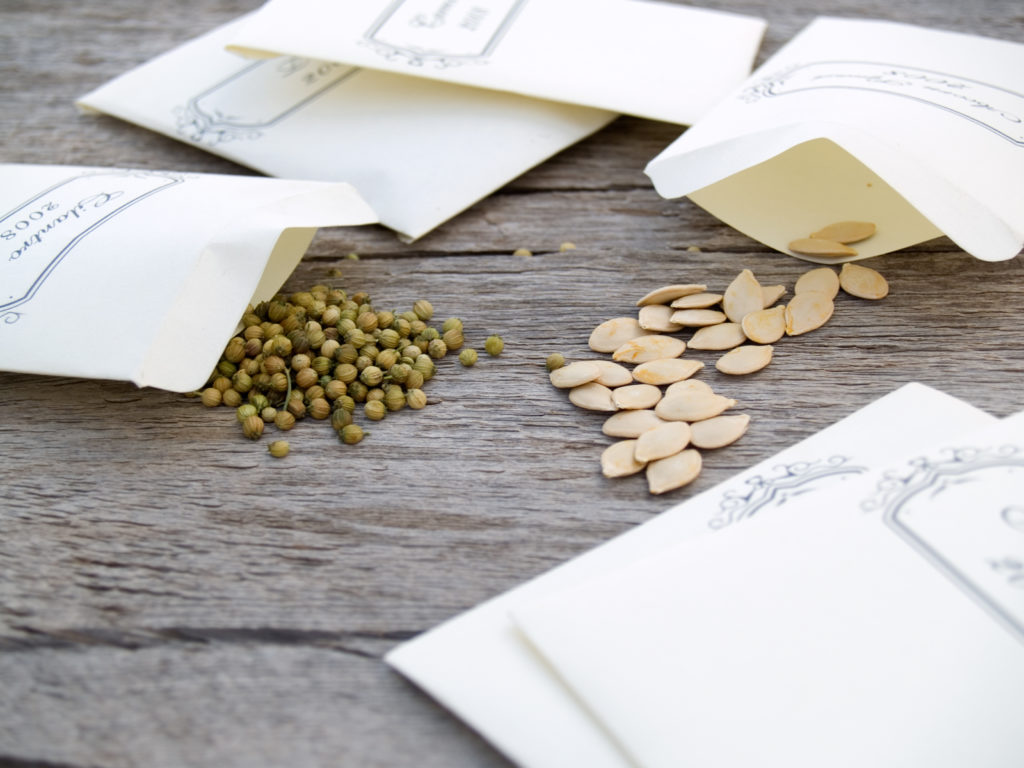
When to start seeds
When it comes to starting seeds for the garden, do not start too early and do not start too late.
Seeds started indoors should be ready for transplanting into the garden when the soil and weather are ready to take the seedlings into their proper growing season. That means the time to start seeds can differ widely. Some plants grow slower and need more time to develop than others. Depending upon where you live, the garden may need more time–the soil and weather may need to warm–to be ready for the crops you have in mind.
Make a seed starting calendar
Track seed starting on a calendar. Mark the approximate frost-free date for your region; that is the average date of the last spring frost. The frost-free date is the estimated day in spring–based on local meteorological records–when nighttime temperatures no longer dip below 35°F (1.7°C). (If you are unsure of the frost-free date where you live, check with the county extension office or the public library.) The exact frost-free date can vary from year to year–by several days or even weeks.
Mark the frost-free date on your calendar and plan indoor and outdoor seed starting times counting backward and forward from that date depending upon the seed you plan to sow. So, for example, if you live in Birmingham, Alabama where the estimated last frost in spring comes on March 20, the first vegetable crops to be started indoors, say celery, which needs a 10 to 12-week indoor start on the season, can be planted about January 10.
Mid-winter is the right time to begin planning the garden season. When you know your frost-free date, you will be able to estimate the indoor seed starting date: you can divide your crops into those that need to be started 10 to 12 weeks before the frost-free date, 8 to 10 weeks, 6 to 8 weeks, and 2 to 4 weeks. Make a list of the dates to start each crop: sow basil, pepper, broccoli, and tomato 6 to 8 weeks before the last frost date; sow zucchini 4 to 6 weeks before the last frost date. Now mark those dates with the crop names on your calendar. You can check seed packets or planting guides to know when to start specific kinds of seeds.
If you plan to sow seeds directly in the garden, keep in mind that annual seeds grow best in the garden when the soil is around 60°F (15.6°C)–sow too early and the seeds may rot before they germinate.
Seed starting indoors step-by-step
Starting vegetables from seeds is a great way to enjoy fresh produce straight from your garden. Here’s a step-by-step guide to help you get started:
1. Choose your seeds: Decide which vegetables you want to grow. Consider the climate, available space, and your preferences. It’s best to choose seeds that are suitable for your growing zone.
2. Prepare the soil: Clear the area or create a raised bed for planting. Loosen the soil using a garden fork or a tiller, breaking up any clumps and removing weeds. Amend the soil with compost or aged manure to provide nutrients.
3. Read the seed packet instructions: Every type of vegetable has specific requirements for ideal growing conditions. The back of the seed packet will provide information on optimal planting depth, spacing, and any special considerations for that particular vegetable.
4. Start seeds indoors (optional): Some vegetables benefit from an early start indoors, especially in colder climates or regions with short growing seasons. Using seed starting trays or individual pots, fill them with seed starting mix and plant the seeds according to the recommended planting depth. Place the trays or pots in a warm location, such as near a sunny window or under grow lights, and keep the soil moist.
5. Direct sow seeds: For vegetables that prefer to be planted directly in the garden, such as carrots, beans, or radishes, wait until the soil has warmed up after the last frost. Make furrows or shallow holes in the prepared soil according to the recommended spacing and planting depth. Place the seeds in the furrows and cover them with soil, gently firming it down.
6. Water regularly: Keep the soil evenly moist, especially during germination. Avoid overwatering, as it can lead to rotting or damping off disease. A light misting or watering from the bottom can prevent disturbance to the seeds.
7. Provide adequate light: If starting seeds indoors, make sure they receive sufficient light. If natural sunlight is not enough, supplement with fluorescent or LED grow lights. Place the lights a few inches above the seedlings and raise them as the plants grow.
8. Harden off seedlings (indoor-started only): Before transplanting the seedlings from indoors to the garden, gradually introduce them to outdoor conditions. Start by placing them in a sheltered area for a few hours a day, gradually increasing exposure to direct sunlight, wind, and temperatures. This process helps the plants acclimate to outdoor conditions and reduces transplant shock.
9. Transplant or thin seedlings: Once the seedlings have developed a few sets of true leaves and reached a suitable size, they can be transplanted into the garden or thinned out if they were directly sown. Follow the spacing recommendations on the seed packet.
10. Maintain proper care: Water the plants regularly, preferably at their base, to prevent foliage diseases. Keep an eye out for pests and treat accordingly. Mulch around the plants to conserve moisture, suppress weeds, and regulate soil temperatures.
11. Monitor growth and harvest: Check your plants regularly, looking for signs of growth, disease, or nutrient deficiencies. Harvest your vegetables when they are ripe and ready to be picked based on the specific vegetable’s harvesting guidelines.
Remember, patience and attention to detail are crucial when starting vegetables from seeds. Providing the right conditions and care will help ensure a successful and bountiful harvest.
Seed starting outdoors step-by-step
Buyer’s Guides:

Seed starting spring through summer
Here’s a simple calendar for seed starting:
Seeds to start indoors in spring
-
- Vegetables: broccoli, eggplant, gourds, peppers, tomatillos, tomatoes.
-
- Herbs: basil, fennel, catmint, lavender, marjoram, oregano, rosemary, thyme.
-
- Flowers: amaranth, Asclepias, buddleia, calendula, carnations, columbine, delphinium, Echinacea, feverfew, foxglove, ornamental grasses, globe amaranth, heliotrope, hollyhocks, nicotiana, pansies, penstemon, phlox, portulaca, rose, salpiglossis, scabiosa, snapdragons, stock, zinnias.
Seeds to sow directly in the garden in early spring
-
- Vegetables: beets, broccoli, broccoli raab, carrots, chard, bulbing fennel, kale, leeks, lettuce, mâche, scallions, pak choi, peas radishes, salad greens, stir fry greens, spinach.
-
- Herbs: arugula, borage, chamomile, chervil, chives, cilantro, dill, garlic chives, parsley, watercress.
-
- Flowers: Agrostemma, alyssum, bells of Ireland, bishop’s lace, calendula, clarkia, cornflowers, cerinthe, delphinium, forget-me-nots, larkspur, nigella, poppies, Rehmannia, stock, sweet peas.
Seeds to sow directly in the garden in early summer
Direct sow these seeds once nights are consistently greater than 50-55°F.
-
- Vegetables: beans, edamame soybeans, beets, carrots, chard, corn, cucumbers, gourds, melons, onions, pak choi, pumpkins, salad greens, stir fry greens, scallions, summer squash, watermelons, winter squash, zucchini.
-
- Herbs: arugula, basil, borage, cat grass, cilantro, dill, sage, thyme.
-
- Flowers: bells of Ireland, cleome, cosmos, cardinal climber, cypress vine, four o’clocks, hyacinth bean vine, love lies bleeding, marigolds, mina lobata, moonflowers, morning glories, nasturtiums, nicotiana, phlox, portulaca, salvia, scabiosa, scarlet runner beans, sunflowers, tithonia, zinnias.
Seeds to sow directly in the garden mid-summer to early fall
Sow mid-summer in cold winter regions. Sow mid-summer to early fall in mild winter regions.
-
- Vegetables: beets, broccoli, broccoli raab, carrots, chard, bulbing fennel, kale, leeks, lettuce, mâche, pak choi, peas, radishes, salad greens, stir fry greens, scallions, spinach.
-
- Herbs: arugula, chervil, chives, cilantro, dill, garlic chives, parsley, watercress.
-
- Flowers: Agrostemma, alyssum, bishop’s lace, calendula, cerinthe, clarkia, cornflowers, forget-me-nots, foxglove, larkspur, nigella, pansies, poppies, snapdragons, stock, sweet peas.
How to buy seed
Purchase seeds from seed companies that are long on information; look for seed packets or seed catalogs that tell you what it takes to start seeds and grow plants: germination temperature and days to germination, days to maturity, when to start the seed, water needs, temperature and weather tolerance, disease resistance, and, importantly, a good description of the vegetable at harvest including flavor. Also, is the crop variety a hybrid or open-pollinated; open-pollinated means you can save seed from mature plants and grow exactly the same crop again next year.
Seed growers can be national or regional. Regional seed companies grow their seed in the same part of the country where they sell their seed. Choosing seeds from a seed company in your region means the plants will easily adapt to your garden and you will get varieties that are regional favorites. National seed companies may grow seeds in many different parts of the country; that usually means they sell seed varieties that are easily grown in any part of the country.
When you buy seeds, consider how much of a crop you want to grow over the course of the season. A seed packet of carrots with 50 to 100 seeds will probably get planted in one season, but a seed packet of squash with 20 or 30 seeds will likely be more than you need in one season.
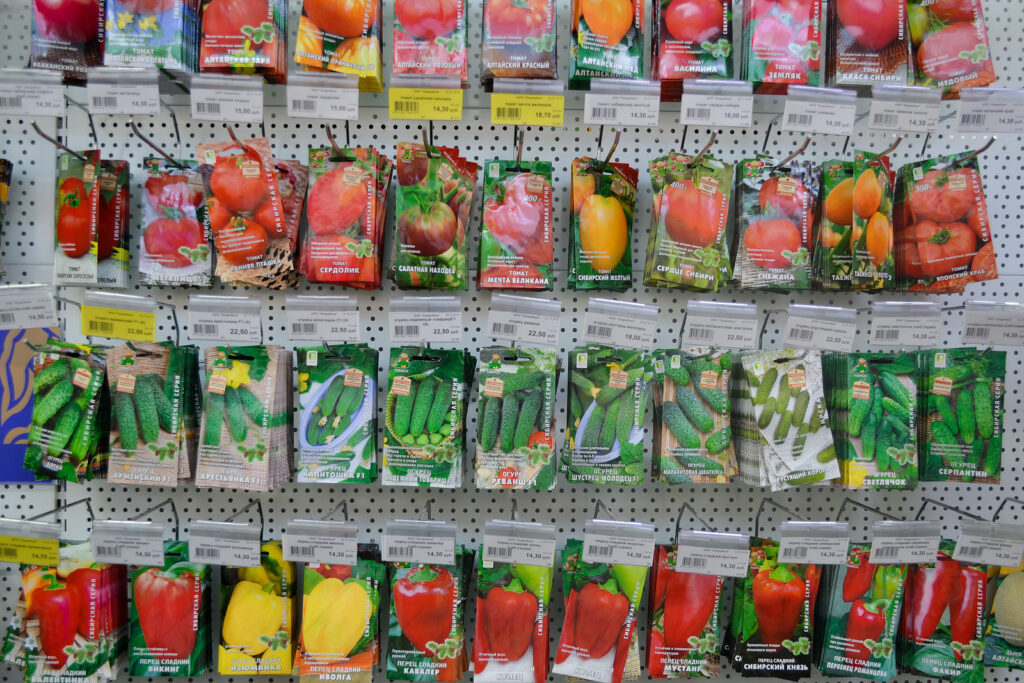
Seed shopping tips
You will save money—starting your own seed is much less expensive than buying transplants—and you can choose from a greater number of varieties than you will ever find in a garden center.
But growing from seed requires time, space, and attention. If you only need a few plants it may be more time and cost effective to have someone get your plants started for you.
Here are things to keep in mind when you go seed shopping:
-
- What do I really want to grow? What do I want to eat?
-
- How much space do I have to grow crops? How much time do I have to garden? Purchase seed with your growing beds and climate in mind and with the amount of work you can reasonably handle.
-
- Determine your seed-sowing and transplant schedule. Consider the length of your growing season and how many successions of crops you can grow in a season.
-
- Start seed shopping in winter. Some seeds may sell out. Be sure you order early enough to sow when you plan.
-
- Check out a variety of seed catalogs to compare selection and price.
-
- Consider the number of seeds in a packet. If your space is limited small seed packets may be the most cost-effective.
-
- Don’t forget to consider the space you have to start seed indoors.
-
- Remember growing from seed requires time, space, and attention. You must have seed-starting supplies on hand once you are ready to begin growing.
-
- Choose varieties and cultivars that have qualities that are important to you, such as plant size and growth habit, soil condition tolerance, and suitability to specific regions and climates.
-
- Decide between hybrids and open-pollinated seed. Hybrid seeds may offer higher yields, disease resistance, and newly developed varieties. Open-pollinated varieties may taste better and produce over a longer season. Seed from open-pollinated plants can be saved for next season.
-
- Consider growing one or two varieties each year that you have never grown before. Look for gourmet cultivars or old-fashioned varieties that you’ve never tried and can’t find at the farmers’ market or grocery store.
-
- Be aware that the number of days to maturity noted in catalogs and on seed packets is an estimate. The actual number of days may be slightly different for your region, climate, and weather conditions.
-
- Consider if the seed has been treated. Some seeds may be treated with synthetic chemical fungicides. If you don’t want treated seed, be sure the seed you order is untreated.
-
- Consider All-American Selections. AAS cultivars tend to grow and produce well in a variety of conditions and regions and are well-suited for gardeners with less experience.
-
- Keep your seed catalogs and packets handy for use as a reference once you begin planting.
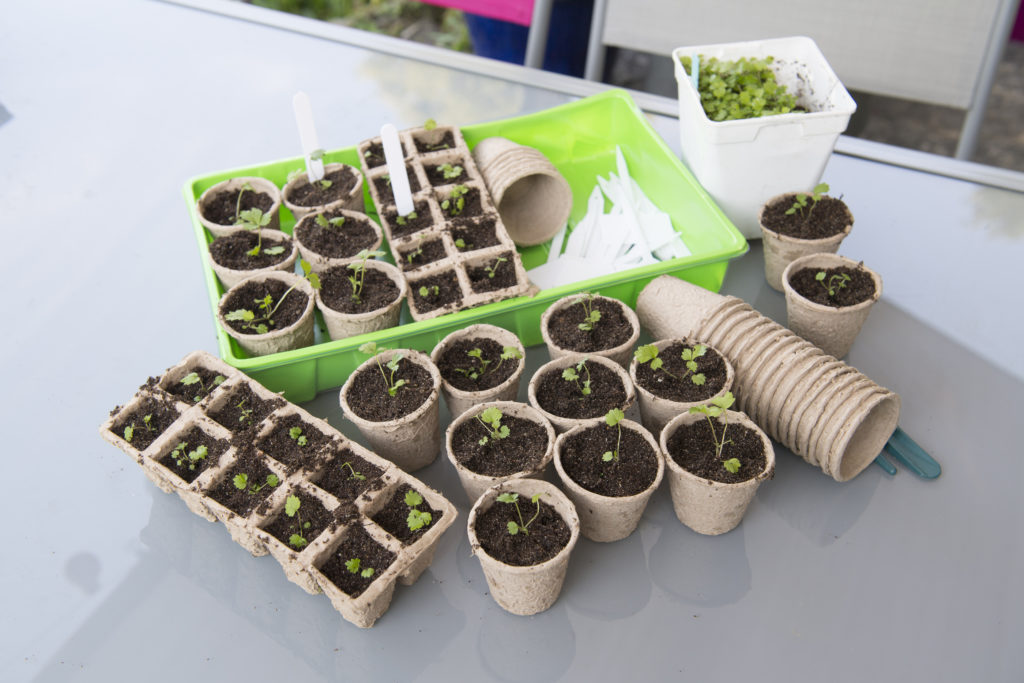
Seed starting supplies – biodegradable pots and trays
Seed starting supplies
It is easy to grow your own plants from seed. By starting your own seedlings you can choose from hundreds of varieties that are not available in garden centers. The cost of plants will be far less than those sold in nurseries. You can also have transplants ready to go into the garden at any time you choose.
Here are the essentials for seed sowing indoors: containers, seed-starting mix (not soil), light source, heat source, water, labels, and markers.
Do an inventory of your seed-starting supplies. Do you have enough containers or flats for starting seeds and transplanting seedlings? Do you have a sterile seed-starting mix? Do you have a heating mat to provide bottom heat for seed germination? Do you have adequate lighting for growing seedlings?
Containers
Choose from plastic seed-starting kits (includes bottom trays, divided plastic containers, sometimes called six-packs, and clear plastic humidity dome covers), undivided shallow wooden or plastic trays–called flats, peat or coir pots, Jiffy pellets, egg cartons, yogurt cups or cottage cheese and butter tubs (be sure to cut drainage holes in the bottom of plastic containers), or paper pots.
Make sure your containers are clean. Wash new and used containers with soap and water and rinse used containers with 10 percent bleach (1 part chlorine bleach to 9 parts water) to sterilize the containers. (Seedlings are very susceptible to disease so it’s important to disinfect containers.)
Germination mix
Prepackaged soilless seed-staring mix or a homemade mix of 1 part fine aged compost and 1 part vermiculite or perlite (1:1 ratio). A soilless mix should be sterile (pathogen-free), light, and loose to avoid compaction, and should absorb water easily but allow excess moisture to drain away quickly. When seedlings are ready to be transferred to a larger pot, switch to potting soil.
Labels and markers
Wooden or plastic labels, permanent markers, pencils, crayons, or grease markers.
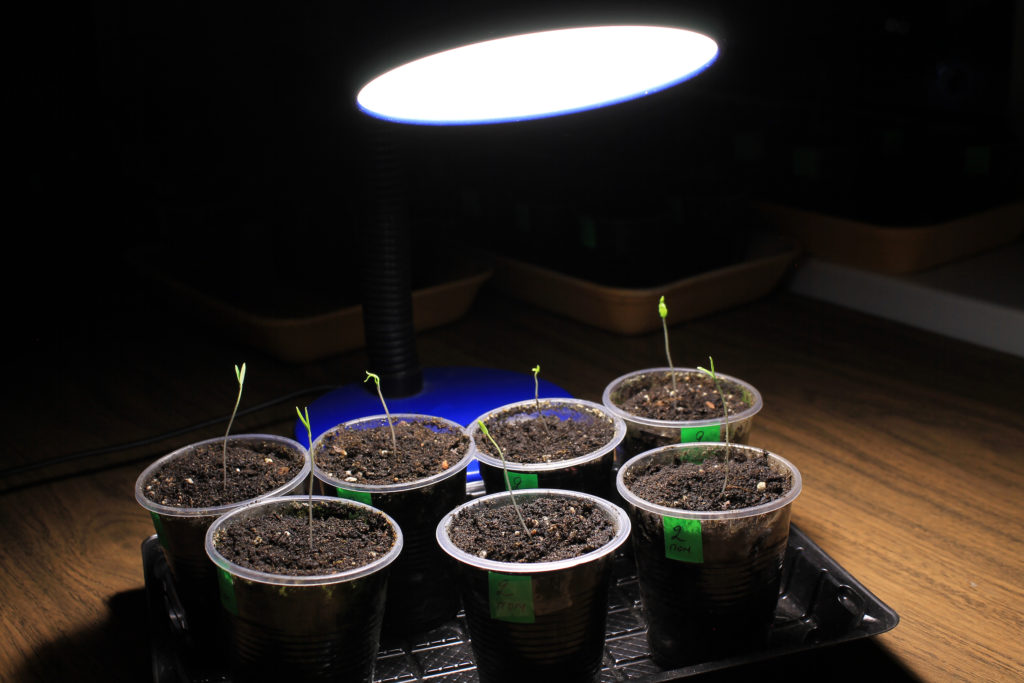
Light Source
Grow lights, cool white bulbs in fluorescent light fixtures, and south- or southeast-facing windows. Because few windowsills get enough light to grow seedlings, your best choice is to use a grow light or two 4-foot-long fluorescent tubes—one “warm white” and one “cool white” tube suspended in an adjustable fixture. Grow lights should be adjustable. The lights should be set or suspended 2 to 4 inches (5-10cm) above the seed-starting mix and later above the growing seedlings (again, a constant two inches above the seedlings’ topmost leaves). A light timer should be set to light the seedlings 16 hours a day. Also see Lights to Grow Plants: Choose the Right Light
Heat Source
Germination heat mat, heating cables or coils, soil thermometer, thermostat, warm location (such as a sunroom or a greenhouse). Most seedlings germinate quickest in warm soil (70° to 75°F/21° to 24°C); set your containers on top of the heating mat or cables and use a thermostat to switch the heat on and off automatically. Once seeds have sprouted remove the cables or set the temperature cooler (the upper 50s to lower 60sF/ 10°-16°C).

Water
Use spring water, non-chlorinated tap water, or rainwater. Use a rigid clear plastic dome or clear plastic bag to maintain high humidity before germination. Use a watering can with a small-holed sprinkling head or use a spray bottle or spray wand that delivers fine droplets of water—don’t spray directly with a hose. If you are starting seed in peat pots, paper pots, or soil blocks, a capillary mat can deliver water as needed; capillary mats allow the seed-starting medium to draw or wick water from a bottom reservoir as needed; a liquid fertilizer can be added to the reservoir to feed larger seedlings.
Fertilizer
Seedlings growing in a soil-free starting mix or lean potting mix will need a small amount of plant food when the first true leaves develop. For the first three weeks after true leaves develop, feed young seedlings once a week using a half-strength solution of fish or seaweed fertilizer, compost tea, or a liquid organic fertilizer specially formulated for seedlings. Starting the fourth week after true leaves develop, feed seedlings every 10 to 14 days using a normal-strength fertilizer solution; fertilizer will not be needed if your transplant your seedlings to a potting mix that has nutrients added.
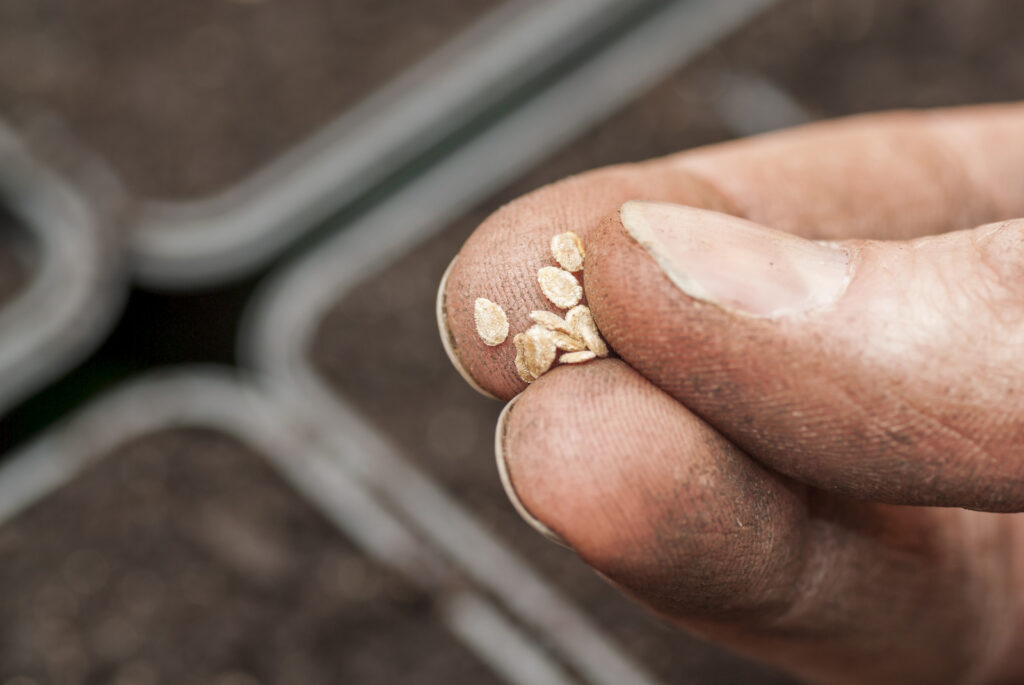
How to start seeds indoors
Planting seeds directly in the garden can sometimes be risky. An unexpected frost or cold spell, a rainstorm, or hot drying winds can reduce germination or wipe out seedlings. Starting seeds in containers indoors and growing them under controlled conditions into robust seedlings can reduce the risk
Step 1. Fill a small container with moist seed starting mix. Sow seeds in four or six-cell plastic packs or in 3- or 4-inch peat pots or individual bio-containers for plants that grow quickly such as beans or squash. Fill each cell or container nearly to the top with a moist seed starting mix. Place one to three seeds in each cell or container. Wet each seed cell with water from a household spray bottle and set the pots in a warm part of the house under fluorescent lights. Place pots or trays in clear plastic bags to create a mini-green house. If you want to spend more, you can purchase a seed starting system at a garden center or online.
Step 2. When seeds germinate, place the containers under fluorescent light for 12 to 16 hours a day. Make sure the seed starting mix stays moist but is not overly wet. When containers dry out set them in a shallow tray filled with water so the starting mix absorbs water from the bottom. Bottom watering will encourage deep rooting and strong plants. Remember to remove the container from the water tray and allow the soil to drain each day. Feed seedlings once a week with a soluble fertilizer diluted to half or one-quarter ordinary rate. Raise the lights as the plants grow to keep the tubes about 2 inches above the top of the leaves.
Step 3. When seedlings grow to 2 or 3 inches tall and develop the first true leaves (which are actually the second set of leaves–the first is embryonic “seed leaves”)–transplant them to individual containers. Use 4-inch plastic or peat pots to grow your seedlings on. Fill the pots with fresh, moistened potting soil. Take each seedling gently by a leaf and lift it gently out of its starting container with a spoon or sharpened pencil or narrow Popsicle stick. Be careful not to disturb the roots and surrounding soil. Poke a hole in the soil of the new container, and insert the seedling and firm soil around the roots. Place the newly transplanted seedling in its individual container under the light again, and water and feed as before.

Transplanting seedlings into the garden
When all danger of frost is past in spring and seedlings are 4 to 6 inches tall, transplant the seedlings into the garden. Before you do, be sure to “harden off” or acclimatize the seedlings to the conditions outdoors. Begin this process by placing the seedlings in an outdoor spot protected from sunlight and wind for a few hours each day increasing to full exposure over several days. In a week or so, the seedlings will be ready for transplanting into the garden.
Planting indoor-grown seedlings in the garden is the same as planting container-grown plants from the garden center. Space plants in the garden according to their size at maturity. Check seed packets or growing guides for proper spacing. Vegetables, annual flowers, and perennials spaced too closely at transplanting will fill in more quickly but will become ungainly and unhealthy as they mature and become overcrowded.
How to transplant seedlings
Step 1: Before transplanting, water plants in containers. The soil should be moist but not soggy. When you have prepared your plant’s new home in the garden, slip the plant and root ball from the pot trying not to disturb the root ball. Gently loosen congested roots on the bottom and lower side of the root ball. Massage apart and separate the roots that encircle the ball.
Step 2: Place the plant into a hole that is slightly larger than the root ball and deep enough to position the top of the root ball at the soil level. Fill the hole about halfway with the soil and moisten the root ball. Add the remaining soil, firming it gently around the base of the stem. Water is essential for new transplants. If nature does not oblige, provide 1 inch of water per week for the full growing season–even for drought-tolerant plants. Check watering requirements for each vegetable and herb you plant. Some require more water early or late in the growing season depending upon the crop.
Step 3: Once seedlings are set in the garden, side-dress the new plantings with aged compost. Sprinkle aged compost around each plant. This will both feed the new plants and also conserve soil moisture. Remove any weeds that appear; weeds compete with vegetables and herbs for nutrients and moisture.
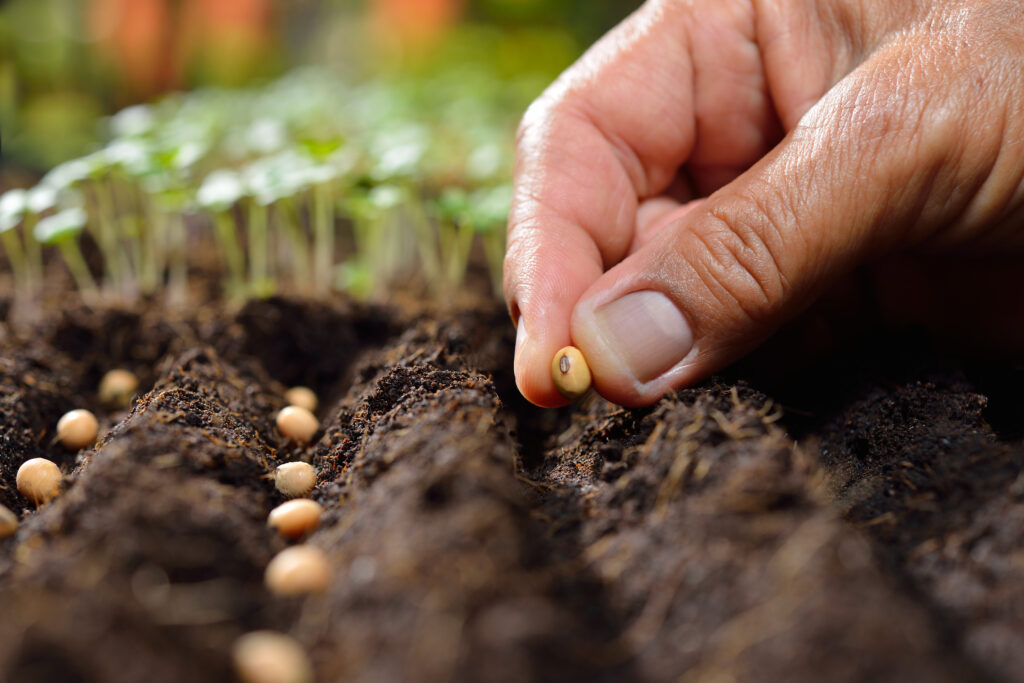
Direct sowing seeds in the garden
Some vegetables and flowers can be directly sown where they will grow in the garden. Seed packets will give you basic information on planting–when, how, deep, and how long until germination.
Step 1: Prepare the planting beds in advance of seed sowing. Add several inches of aged compost and aged manure across the top of the planting bed. Next, turn the soil with a spade to a depth of 8 to 10 inches; this will aerate and loosen the soil. Next, remove rocks and roots and then rake the planting bed smoothly. (To learn more about your soil and what you need to improve it, call the nearby Cooperative Extension Service.)
Step 2: Sow seeds following the planting directions on the seed packets. For vegetables and most flowers, sow 3 to 5 seeds in the spot where you want to grow a single plant (later, you will thin to the strongest seedling). Cover the seed with a fine layer of soil or compost as recommended on the packet and water gently and thoroughly. Keep the planting bed just moist until seeds germinate.
Step 3: When garden-sown plants have formed their first true leaves, thin plants to the recommended spacing and continue to water regularly. A layer of garden compost or straw around plants or a covering of light horticultural fabric can help conserve moisture.
Seed Starting & Propagation Learning Hub
Start here — Seed Starting Basics: A Complete Beginner-to-Advanced Guide for Indoor and Outdoor Seed Starting
Seed Starting Fundamentals
- Seed Starting Guide
- Starting Plants from Seed
- Vegetable Seed Starting Indoors and Out
- How to Start Seeds Indoors Step-by-Step
- Starting Vegetables Indoors: 15 Varieties for Success
- Vegetable Seed Germination
- How to Read a Seed Packet
Planning & Timing
- Seed Starting Calendar: When to Start Seeds Indoors and Outdoors
- Spring Outdoor Seed Sowing Schedule
- Seed Catalog Guide: How to Choose the Best Seeds for Your Garden
- Vegetable Seed Buyer’s Guide
Seed Starting Tools, Supplies & Setup
- Essential Seed Starting Supplies
- Seed Starting Mix Buyer’s Guide
- How to Make Your Own Seed Starting Mix
- Seed Starting Tray Buyer’s Guide
- Peat Pot Buyer’s Guide
- Seedling Heat Mat Buyer’s Guide
- Best Lights for Starting Seeds Indoors (and How to Use Them for Strong, Compact Seedlings)
- Lights to Grow Plants: Choose the Right Light
Seedling Care, Troubleshooting & Success Tips
- Troubleshooting Seed Starting Problems: Leggy Seedlings, Damping Off, Weak Growth, and More
- How to Avoid Leggy Seedlings When Starting Indoors Under Lights
- Seed and Seedling Failure Troubleshooting
- Vegetable Seedling Protection
- How to Thin Vegetable Seedlings
Buyer’s Guides:
Seedling Heat Mat Buyer’s Guide
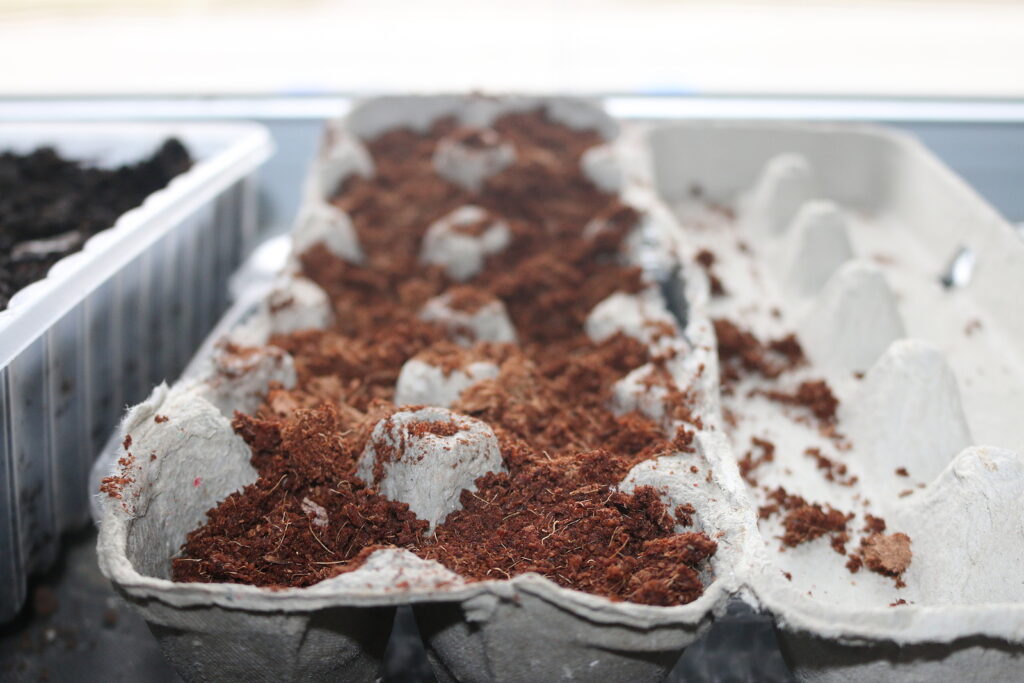
Seed starting for kids
Getting seeds started indoors can be as simple as re-purposing pressed-paper egg cartons. Egg carton cups are just the right size for starting seeds and growing seedlings to size. Half egg shells and newspaper cones set in egg carton compartments will work just as well.
Poke a hole in the bottom of each egg compartment (or eggshell or newspaper cone) and fill with moistened sterile seed starting mix. Use the egg carton lid as a tray beneath the compartments.
Sow two or three seeds in each compartment and just cover them with seed starting mix; the rule of thumb is to cover seeds to a depth of three times their diameter.
Use a clear plastic bag as your seed-starting greenhouse. Place the egg carton in the plastic bag (don’t tie the bag–germinating seeds need fresh air) and set it in a warm, light place–on a kitchen countertop or under fluorescent lights. A consistent temperature of about 70 to 75°F is best to ensure quick sprouting. Keep the starting mix just moist until the seeds germinate; remove the plastic bag if mold should start to grow.
When the seeds germinate (you’ll see green shoots), take the carton from the plastic bag and set it on a light but not too bright windowsill. (Direct sunlight through window glass may burn young seedlings.)
Let the seedlings grow for two weeks–enough time to form true leaves–then use small scissors to snip away the smaller and weakest of the seedlings at the soil level. Leave the strongest seedling to thrive. (Avoid pulling seedlings from their starting compartments so as not to disturb young roots.)
Grow seedlings on for another two weeks being sure to keep the soil just moist–do not let the seed-starting mix dry out. Use liquid organic fertilizer at quarter strength when you water new seedlings. When more than two sets of leaves have emerged, give the seedlings up to one-third strength of liquid fertilizer.
Four to six weeks after germination, indoor started seedlings will be ready for potting up or transplanting out in the garden. Before seedlings go into the garden they should be hardened off–placed in a sheltered outdoor place for a few hours each day and allowed to acclimatize to outdoor conditions, a process that can take up to two weeks depending upon the weather.
Once seedlings are hardened off, the seed-starting egg cartons, egg shells, or paper cones can be gently crushed or cut apart and then transplanted whole into the garden without disturbing the seedlings’ roots. Egg cartons, egg shells, and newspaper cones will decompose quickly once set in the ground. Most seedlings should be planted no deeper than they were in the seed-starting container.
Starting seeds indoors can give you a four to six-week head start over seeds sown directly in the garden.
Also of interest:
Vegetable Seed Starting Indoors and Out
Seed and Seedling Failure Troubleshooting
How to Thin Vegetable Seedlings
Average Last and First Frost Dates for Cities
Garden Planning Books at Amazon:



